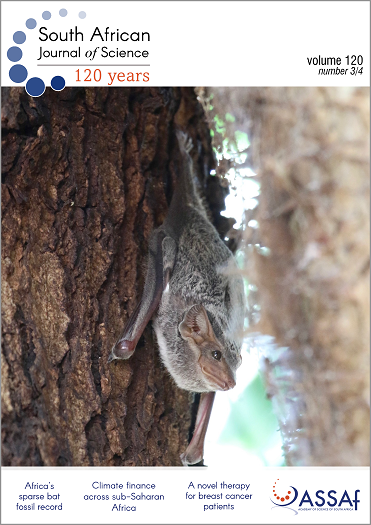AgERA5 representation of seasonal mean and extreme temperatures in the Northern Cape, South Africa
DOI:
https://doi.org/10.17159/sajs.2024/16043Keywords:
heat waves, cold waves, AgERA5 reanalysis, weather stations, data set evaluationAbstract
Over regions with sparse observation networks, including South Africa’s Northern Cape Province, gridded data sets represent valuable supplementary data sources enabling spatially detailed climate investigations. Their performance is, however, influenced by regional characteristics, thus a performance assessment should be a prerequisite for any regional application. Through a pairwise comparison with eight point-based temperature records, we evaluated the AgERA5 data sets representation of mean summer (November–March; Tms) and winter (May–September; Tmw) temperatures and respective seasonal heatwave and coldwave characteristics across the Northern Cape for 1980–2020. Correlations ranging from 0.48 to 0.92 for Tms and from 0.38 to 0.94 for Tmw reflect relatively strong, but varying, temporal correspondence between the AgERA5 data and stations. Low biases, averaging −0.08 (0.17) °C and ranging from -0.79 to 2.10 (-0.40 to 1.47) °C for Tms (Tmw) were evident. Biases for the heatwave (coldwave) magnitudes were low, averaging -0.38 (0.19) °C2, and ranging from -1.55 to 1.47 (-2.05 to 2.91) °C2. Biases for the heatwave (coldwave) frequency were also low, but typically overestimated, averaging 1.19 (0.73) days, and ranging from -1.33 to 5.60 (-1.61 to 3.39) days. Biases for the heatwave (coldwave) number were low and typically overestimated, averaging 0.27 (0.08) events, and ranging from -0.28 to 1.40 (-0.39 to 0.39) events. Despite some stations depicting consistently poor performance, the study results support further application of the AgERA5 product for spatiotemporal analyses of mean and extreme temperatures across the Northern Cape, provided limitations are adequately acknowledged. Further application of the fine-resolution AgERA5 product will greatly inform impact-based studies exploring mean and extreme temperature influences over the Northern Cape Province.
Significance:
- The AgERA5 product was assessed on its performance in representing average and extreme temperature characteristics over South Africa’s Northern Cape Province.
- Good comparability between the AgERA5 product and point-based observations supports further application of the AgERA5 across the Northern Cape.
- The AgERA5 product offers a spatially detailed picture of mean and extreme temperatures across the Northern Cape, which is valuable for regions where weather stations are not available.
- The AgERA5 product is thus important for impact-based studies assessing, for instance, the impact of extreme temperatures on livestock and human health.
Downloads
Published
Issue
Section
License

All articles are published under a Creative Commons Attribution 4.0 International Licence
Copyright is retained by the authors. Readers are welcome to reproduce, share and adapt the content without permission provided the source is attributed.
Disclaimer: The publisher and editors accept no responsibility for statements made by the authors
How to Cite
- Abstract 576
- PDF 565
- EPUB 135
- XML 185
- Supplementary material 445












.png)